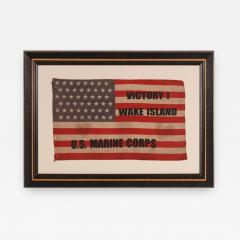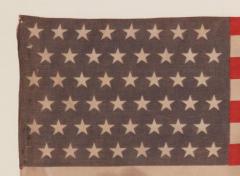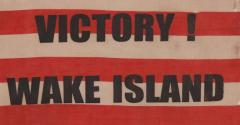"Victory at Wake Island U.S Marine Corps" Overprinted Parade Flag
-
Description
"Victory at Wake Island U.S. Marine Corps ": Rare overprinted parade flag celebrating the significant events at this remote location at the beginning of WWII:
48 star American national parade flag, printed on cotton. Overprinted in the stripe field, in bold, black letters, is the following text: "Victory at Wake Island U.S. Marine Corps." Unique among known examples of American parade flags, this bold example is significant for not only its historical importance and graphics, but because American flags with overprinted text are so rare in this late period.
During the 19th century, it was perfectly acceptable to print on the American flag for the purposes of promoting political campaigns, stores and their merchandise, products and events. Also popular was the decoration of printed flags with the names, numerical designations, and badges of military veterans' units and fraternal chapters. In the late 1880s, when flag ethics began to emerge, the practice of using American National symbols for the purpose of advertising began to fall out of favor. Certain states banned it with various legislation. The matter was placed before Congress twice during the 1890's and finally became illegal by Congressional law in 1905. Though this did not put an end to the practice, it had already fallen by the wayside in popularity. Veterans continued to use overprinted designs for reunions and parades, certainly having earned the truest right to the stewardship with regard to the flag's use and care. This generally disappears by the 1920s, however, and by WWII (1941-1945) overprinted flags were basically extinct. Just a handful of examples survive with overprinted text that were made in the 70-75 year period that has passed between 1941 and today.
Perhaps just four legitimate examples of printed parade flags are known that have an overprint that reads “Remember Pearl Harbor” in one format or another. I have been privileged to have owned two of these. The remaining two reside in the collection of Richard Pierce and are documented in his book "The Stars & The Stripes: Fabric of the American Spirit" (J. Richard Pierce, 2005) on page 72. This is the only other flag known with a WWII message, beyond that small group. Among them it is the largest, has the largest text, and is the only one related to an event other than Pearl Harbor.
A Brief History of the Battle of Wake Island:
Victory or Defeat? It's been described by both terms, but what is universally agreed upon is the extraordinary bravery of U.S. Marines in stalwart defense of this remote location, which is just about as far from anything as one can possibly imagine. Approximately 5,000 miles off the coast of California, with Hawaii at approximately the half-way point inbetween, it is then 3,000 miles further to the Philippines or just over 2,000 to Japan. Wake is actually an atoll, which is basically the rim of a volcano or former volcano, emerging from the water, sometimes with an island in the center (though not in this particular case). In January of 1941, the U.S. Navy established an airfield and military base on the island, manning it with approx. 450 officers and enlisted men from the 1st Marine Defense Battalion. These were complimented by 68 navy personnel, 1,221 civilians, and 45 Chamorros (natives from Micronesia and Guam). Marine defenses consisted of various heavy guns and 12 F4F-3 Wildcat fighter aircraft.
When Japan attacked and crippled Pearl Harbor on December 7th of that year, they simultaneously attacked Wake Island (where it was actually Dec. 8th, as it lay beyond the international date line). Japanese forces simultaneously struck the Philippines, as well as British forces in Malaya. Hong Kong was still in British hands, but hopelessly surrounded, with hope of neither resupply or relief.
36 Japanese bombers formed the attack, deployed from the Marshall Islands. 8 of the 12 fighters were destroyed, but none of the heavy gun positions. The remaining planes were in the air at the time, but were unaware of the siege due to poor visibility. 23 Marines were killed and 11 wounded. Two more bombing raids followed shortly thereafter, destroying the hospital and an air facility operated by Pan Am, whose employees had already been evacuated. Several Japanese bombers were shot down, but the American guns, cleverly moved and hidden by the Marines, went unscathed.
The first invasion attempt occurred on Dec. 11th, just 3 days after the initial attack. After reading numerous accounts of the battle and verifying facts from several sources, I found the following summary to be the most concise and well told. This is in some places copied word-for-word and in some places paraphrased from the writings of an unidentified WWII historian in a non-copyrighted source:
"At 0530 local time, a force of three Japanese light cruisers and six destroyers, accompanied by two old patrol boats and two transports began a brief bombardment of the island. The Marine shore batteries held their fire, not wanting to disclose their location until the Japanese were as close as possible, and with the exception of a couple of hits, the Japanese gunners where not very impressive to the Marines.
The base's new commander, Winfield S. Cunningham, who had just arrived on November 28th, wanted to open fire, but Major James Devereux, commander of the Marine unit, held firm, hoping to maximize damage from the limited number of guns his Marines had available.
At 0620 local time, the Marines opened fire. Several 5" shells struck the destroyer Hayate, at a range of about 3,200 yards, causing her to explode and sink. The cruiser Yubari, flagship of Rear Admiral Sadamichi Kajioka, the commander of the invasion force, was believed to have been hit by as many as nine 5" shells, damaging her superstructure, knocking out one of her guns, and killing 22 crewmembers.
Realizing his forces were not adequate to the task of taking the island, Kajioka made plans to call off the landing attempt, but unfortunately it was too late for one of the worst events of the battle. At 0702 local time, a shell from Marine guns of Battery L on Wilkes Island landed a hit on the light cruiser Tenryu of cruiser division 18. The shell struck the bridge, killing or wounding everyone there, leaving the ship temporarily out of control. The cruiser Tatsuta close behind the Tenryu, and not realizing the other cruiser had lost her steering, was turning away from Wake in too wide of an arc. Moments later, the cruisers collided, the Tenryu having her stern damaged and becoming dead in the water. The Tatsuta had her bow damaged, and was forced to halt. Now perfect stationary targets for the Marines, the Tatsuta subsequently suffered at least 17 hits, causing numerous casualties, starting fires, and allowing uncontrollable flooding in parts of the ship, while the Tenryu, starting to drift and having taken a 5 degree list to port, was also struck several times. Within half an hour, both ships would slip beneath the waves, taking over 700 crewmembers with them.
The final blow to the battle was delivered by the Wildcats of VMF-211, having strafed the Japanese destroyer Kisaragi, and setting off her depth charges. The other surviving ships of the ill fated invasion attempt took some damage and casualties, but otherwise where able to withdraw to the anchorage at Kwajalein Atoll for repair and to offload wounded.
All told, the Japanese had lost two destroyers, the two cruisers of Cruiser Division 18, and roughly 1,000 casualties. Losses to Wake amounted to 6 Marines and 9 civilian contractors killed, and a Wildcat disabled on a rough landing.
Unknown to the Marines at the time, another victory of sorts had been achieved in that they had unknowingly killed the first Japanese Flag Officer in World War 2. Rear Admiral Kunimori Marumo, commander of the ill fated Cruiser Division 18, was lost in battle when his cruisers were sunk."
On December 23rd Japan launched the second invasion. Reinforced by two aircraft carriers and 1,500 Japanese marines, the island was lost to American control. It was the events of December 11th, however, where victory was both claimed and due. Losses of just 6 U.S. Marines versus 1,000 Japanese, and the successful deterring of the entire invasion force was a significant morale-lifting event in the wake of Pearl Harbor.
After the raid, Commander Cunningham was incorrectly reported as having quipped "Send us more Japs!" What he actually did was request a long list of badly needed equipment, but the effects of the misreporting went a long way in lifting American spirits and the Battle of Wake Island is remembered as one of the greatest victories of the entire war.
Star Configuration:
On June 24th, 1912, President Howard Taft signed an Executive Order that dictated the first official star configuration for the American national flag. The 47th and 48th stars were added just 10 days later, reflecting the recent addition of New Mexico and Arizona, which gained statehood on January 6th and February 14th, respectively.
While numerous designs were unofficially submitted for consideration (there was no formal competition, as often claimed,) Taft took direction from the War Department. The pattern he selected consisted of 6 justified rows of 8 stars, in neat, military style.
The stars of the flag in question here are arranged in 6 staggered rows of 8 and thus do not conform to the official pattern. Because the Executive Order only applied to those flags made for the Department of the Government, meaning government and military use, Stars & Stripes flags produced for private consumption were unaffected. This is one reason that other designs are seen, and because flag-makers had been allowed to choose their own star patterns for the previous 135 years, it should come as no surprise that some did not follow government specifications.
Among surviving 48 star examples, one may find staggered row patterns that date both before and after the 1912 order. Some flag makers had long been adding stars before their respective states were officially added. Called “anticipatory flags” these were a reflection of both expansionism and American capitalism, as eager flag-makers searched for a reason to make new flags to market to potential buyers. I have seen 48 star, staggered row pattern examples with penciled or printed dates as early as 1896, a full sixteen years before the 47th and 48th stars would actually be added.
In terms of those flags made after 1912, evidence of continued production can be seen in the many WWI (U.S. involvement 1917-18) photographic images show patriotic Americans waving 48 star flags with the staggered row format. The most likely window of production for a staggered row pattern flag thus falls between the late 1890's and 1918. Those dating after WWI are especially scarce. They do appear to have been made and/or used later, but I have only on the rarest occasion encountered them in WWII photographs. This is one of the rare instances that I have ever seen a datable, WWII period example.
Mounting: The flag was mounted and framed within our own conservation department, which is led by masters degree trained staff. We take great care in the mounting and preservation of flags and have framed thousands of examples.
The background is 100% hemp fabric or a hemp and cotton blend, ivory in color. The three-part frame consists of a black-painted, hand-gilded and distressed, Italian molding, with a double-bevel, followed by a narrow, hand-gilded, rippled profile molding, followed by a liner that has a scooped profile and a finish that is very dark brown, almost black, with reddish highlights and undertones. Spacers keep the textile away from the glass, which is U.V. protective.
Condition: There is significant fading of the blue canton. There is modest soiling along the hoist end, as well as in two heart-shaped areas located between the 8th and 10th stripes. There is minor staining in other limited areas. There are small holes running in vertical rows along both the hoist and fly ends, accompanied by tears in the 10th and 11th stripes, surrounding the letters "U.S.," and there are tiny, pinprick-sized holes in the 11th and 13th stripes. Many of my clients prefer early flags to show their age and history of use.
Frame size (H x L): 23.75" x 32.5"
Flag size (H x L): 14" x 22.75". -
More Information
Origin: United States Period: 1920-1949 Condition: Good. See Item Description. Creation Date: 1941 Styles / Movements: Americana Incollect Reference #: 240202 -
Dimensions
W. 32.5 in; H. 23.75 in; D. 2 in; W. 82.55 cm; H. 60.33 cm; D. 5.08 cm;
Sold






















